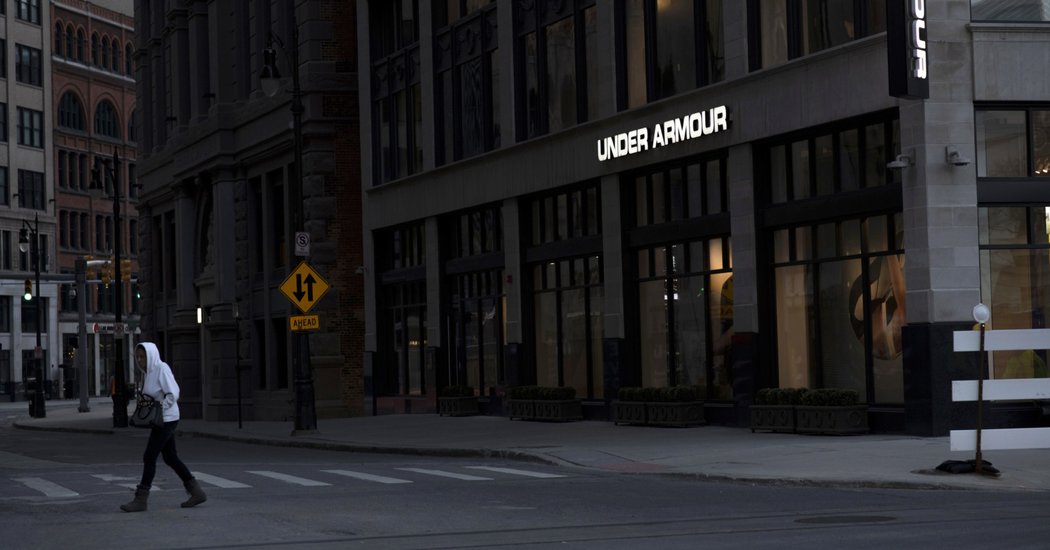
Just a few years ago, Under Armour was on fire.
Revenues for the sportswear giant were growing at an incredible clip. Profits were robust. Its celebrity endorsers included the basketball star Stephen Curry, the golfer Jordan Spieth and the ballet dancer Misty Copeland. Investors, enamored with the company and its high-tech apparel, sent its stock soaring to a high of more than $51 a share in the fall of 2015.
The hot streak is decidedly over.
The latest wave of bad news started on Sunday night when the company, which is based in Baltimore, confirmed it was assisting federal authorities who are investigating its accounting practices and related activities dating back to 2017.
Then, on Monday, Under Armour reported revenue declines for the fifth straight quarter in North America — its biggest market — and cut its forecast for the year, predicting that revenues for the entire company would grow only 2 percent this year. The company’s stock sank over 18 percent on Monday, ending the day just above $15 a share.
And Under Armour is already dealing with leadership changes. Last month, the company announced that Kevin Plank, who started Under Armour from his grandmother’s basement more than 20 years ago, was stepping away from his role as chief executive on Jan. 1.
Under Armour built its brand — and brought in $5 billion in annual revenue — by creating high-tech performance apparel for athletes, items that did things like wick away moisture (i.e., sweat) or regulated body temperature during workouts or competition. But in the past two years, the company has struggled to find its footing as rivals like Nike and Adidas have notched big gains largely from their move into so-called athleisure wear.
Under Armour’s once-robust profits turned to net losses the last two fiscal years.
“A few years ago, they were cooking right along,” said Sam Poser, a research analyst at Susquehanna Financial Group. He added, “But how are you going to drive top-line growth here? Nike, Puma, Adidas and others are all killing it right now.”
Much of Under Armour’s struggles started in 2016 when retailers like Sports Authority, Gander Mountain and Sport Chalet began to file for bankruptcy. Scrambling to find other places to sell its wares, Under Armour moved into discount retailers like Kohl’s and DSW in 2017, resulting in lower prices for its apparel and shoes.
Under Armour’s direct-to-consumer business, which includes online sales and makes up about a third of its business, is struggling as well. In the third quarter, Under Armour said footwear revenue decreased 12 percent and direct-to-consumer slid 1 percent.
“Earlier this year on investor day, Under Armour laid out ambitious targets for footwear and direct-to-consumer and clearly they are not able to show progressive momentum in either,” said Camilla Yanushevsky, an analyst at CFRA Research.
Under Armour has been in the midst of a significant restructuring, cutting jobs, slashing inventory levels and reducing the use of promotions or sales in an effort to re-establish itself as a premium-priced brand.
Success in those areas helped drive a big jump in its profit margins and propelled Under Armour’s earnings in the quarter above analyst expectations.
Patrik Frisk, 56, Under Armour’s president and chief operating officer, will take over as C.E.O. in January. Mr. Frisk will also continue to be its president. Mr. Plank, 47, will become executive chairman of the board and brand chief.
In an earnings call with Wall Street analysts after Under Armour announced its quarterly results, Mr. Plank assured analysts that the company was well positioned heading into next year.
“We are putting our heads down and getting work,” Mr. Plank said. “As we move into the end of 2019 and head towards 2020, Under Armour is ready to run. We are ready to be the great brand that we talk about so often.”
Despite the talk about Under Armour’s future, there was concern among analysts and investors about potential problems from its past.
On Sunday night, The Wall Street Journal reported that the Securities and Exchange Commission and the Justice Department were looking into whether Under Armour had shifted sales results from quarter to quarter to appear healthier, dating back to 2017.
The apparel maker posted 20 percent or greater year-over-year revenue growth for 26 straight quarters until late 2016.
On Jan. 31, 2017, Under Armour’s stock plunged 23 percent in one day after the company said that it would miss revenue-growth expectations and that its chief financial officer was departing after 13 months “for personal reasons.”
David Bergman, who took over as acting finance chief in February 2017 before being formally given the role that December, said on the call that Under Armour had been “fully cooperating” with the investigations for two and a half years.
“We began providing responses in July of 2017 to all requests for documents and information,” Mr. Bergman told analysts. “We firmly believe that our accounting practices and disclosures were appropriate.”







